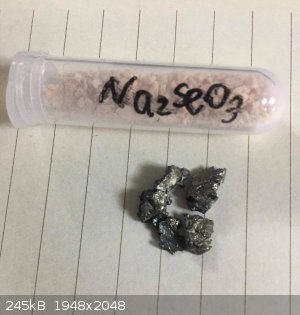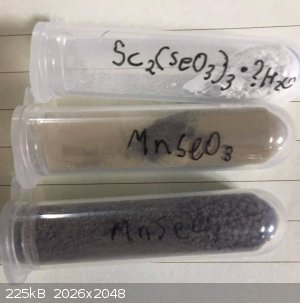vano
National Hazard
   
Posts: 661
Registered: 22-3-2019
Location: Georgia
Member Is Offline
|
|
Scandium selenite and new manganese selenite + photos
Hi. Today I made scandium selenite. I dissolved scandium in hydrochloric acid and added a solution of sodium selenite. The picture shows anhydrous
sodium selenite and scandium metal. I knew the color would not be Scandium Selenite, though I assumed it might have been pink. It has a white color
and is usually hydrated. I'm going to get anhydride from it. I wonder if it will be white too. It is a very rare compound, so it was worth its
synthesis.
I made manganese selenite before and it had a weird color. It was written in a Chinese source that it is pink. Mine is brown. There was no
specification whether the compound was dry as the suspension does indeed have a pink color. I used manganese sulfate tetrahydrate instead of
carbonate. The selenite in the middle is new and the one below is old. The colors are different because I dried them at different temperatures. The
top contains more water.


|
|
|
Bedlasky
International Hazard
    
Posts: 1239
Registered: 15-4-2019
Location: Period 5, group 6
Member Is Offline
Mood: Volatile
|
|
Sc3+ salts are colourless.
That brown and dark brown-black colour look like some Mn(III) or Mn(IV) compound.
|
|
|
vano
National Hazard
   
Posts: 661
Registered: 22-3-2019
Location: Georgia
Member Is Offline
|
|
Quote: Originally posted by Bedlasky  | Sc3+ salts are colourless.
That brown and dark brown-black colour look like some Mn(III) or Mn(IV) compound. |
Mostly I agree with you, but some of them have a color like chromate, I do not know if there is a dicronate but I am sure they will have it, I have
scandium, although I do not want to spend on similar reactions, because it is very expensive. Many organic salts also have color, such as scandium
oxyquinolate. It is a yellow compound. Many other salts can be found if we replace oxygen in a particular anion with chlorine, bromine, sulfur, and
selenium. Chlorochromate, tetrathio... You know what I mean.
Yesterday I made sure it is really manganese selenite because the first time it came out dark I tried it a second time with another compound and got
the same result. I do not know how to pass both substances into (III) or Mn (IV).
|
|
|
woelen
Super Administrator
        
Posts: 8012
Registered: 20-8-2005
Location: Netherlands
Member Is Offline
Mood: interested
|
|
I don't belive that the dark compounds are pure MnSeO3. I expect that to be pale pink, maybe a little off-white/brownish, but not as dark as what you
show here.
Try the same reaction with manganese sulfite. Do you get a pale compound, or do you get something dark brown?
Very pure sodium selenite is white, but commercial samples are off-white, like the one shown by you. This is due to formation of a little red selenium
in the production process of the sodium selenite. My sodium selenite also has a pale brownish color. But the amount of impurity is very low and does
not interfere with experiments. I do not think that the dark brown color of your manganese compounds is due to the impurity of your Na2SeO3. Most
likely the brown color of the MnSeO3 is due to partial oxidation of manganese(II) to manganese(III) or even manganese(IV). In alkaline solutions,
manganese(II) is VERY sensitive to oxidation!
|
|
|
Bedlasky
International Hazard
    
Posts: 1239
Registered: 15-4-2019
Location: Period 5, group 6
Member Is Offline
Mood: Volatile
|
|
Quote: Originally posted by vano.kavt  |
Mostly I agree with you, but some of them have a color like chromate, I do not know if there is a dicronate but I am sure they will have it, I have
scandium, although I do not want to spend on similar reactions, because it is very expensive. Many organic salts also have color, such as scandium
oxyquinolate. It is a yellow compound. Many other salts can be found if we replace oxygen in a particular anion with chlorine, bromine, sulfur, and
selenium. Chlorochromate, tetrathio... You know what I mean.
Yesterday I made sure it is really manganese selenite because the first time it came out dark I tried it a second time with another compound and got
the same result. I do not know how to pass both substances into (III) or Mn (IV).
|
But colour of scandium chromate is yellow because of chromate anion, not because of scandium.
Metals, which mostly form colourless salts, sometimes form coloured complexes. For example - Zr, Hf, Nb and Ta don't have very atractive aqueous
chemistry, because they form colourless complexes. But I found cca two month ago document which mentioned some very sensitive tests for these metals -
for example coloured precipitates with tannin or quercetin.
Mn(II), which forms mostly white or pink salts, form orange complex with molybdate in acidic solution, which is also quite unusual coloured Mn(II)
compound.
|
|
|
vano
National Hazard
   
Posts: 661
Registered: 22-3-2019
Location: Georgia
Member Is Offline
|
|
Quote: Originally posted by woelen  | I don't belive that the dark compounds are pure MnSeO3. I expect that to be pale pink, maybe a little off-white/brownish, but not as dark as what you
show here.
Try the same reaction with manganese sulfite. Do you get a pale compound, or do you get something dark brown?
Very pure sodium selenite is white, but commercial samples are off-white, like the one shown by you. This is due to formation of a little red selenium
in the production process of the sodium selenite. My sodium selenite also has a pale brownish color. But the amount of impurity is very low and does
not interfere with experiments. I do not think that the dark brown color of your manganese compounds is due to the impurity of your Na2SeO3. Most
likely the brown color of the MnSeO3 is due to partial oxidation of manganese(II) to manganese(III) or even manganese(IV). In alkaline solutions,
manganese(II) is VERY sensitive to oxidation! |
This sodium selenite contains selenium particles, although the previous time I used sodium selenite pentahydrate, which I bought but discarded. I do
not think sodium selenite is to blame. The suspension was pink indeed. Manganese carbonate is white in suspension but brown well-dried. There may be
some connection. When I bought manganese carbonate it also had a brown color.
|
|
|
vano
National Hazard
   
Posts: 661
Registered: 22-3-2019
Location: Georgia
Member Is Offline
|
|
Yes i know that. When I wrote, you know what I mean, I meant that because of the anion. That scandium compounds have color. You said: Sc3 + salts are
colorless. And I have given examples where its salts have color. You did not specifically say that Scantium trication is colorless.
|
|
|